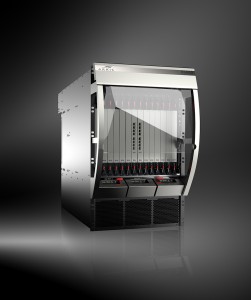DOCSIS 3.1: Cable changes gear
 DOCSIS has over the last decade and a half transformed the very nature of the cable business. Its latest iteration – DOCSIS 3.1 – now promises to extend the life of the HFC network well into the future. Stuart Thomson reports on the current state of play.
DOCSIS has over the last decade and a half transformed the very nature of the cable business. Its latest iteration – DOCSIS 3.1 – now promises to extend the life of the HFC network well into the future. Stuart Thomson reports on the current state of play.
Cable operators are now facing increasing competition from fibre rollouts by well-resourced telco competitors. There are also growing demands on their networks through the use of broadband to deliver and consume every greater quantities of video, as well as online gaming and cloud applications. As a consequence, operators are once again laying the groundwork for an upgrade of their infrastructure to deliver higher speeds and expand the bandwidth available for broadband services.
Telco competitors are now actively competing in the very high-speed market – the above 30Mbps segment – that was once largely cable’s preserve, and are capable, where they have deployed FTTH networks, of equaling or beating cable on top-line speeds.
However, cable still has one or two tricks up its sleeve. The cable operators’ advantage has always been the flexibility and upgradability of the HFC network. The latest innovation designed to extend the life of that network and thereby avoid for a while longer the need for a full – and prohibitively expensive – FTTH deployment is DOCSIS 3.1.
DOCSIS 3.1 is designed to unleash higher bandwidths through a reconfiguration of the way the cable broadband technology uses spectrum. Instead of the traditional 6MHz or 8MHz channels used to deliver data services with previous editions of DOCSIS, the latest version employs Orthogonal Frequency Division Multiplexing (OFDM) subcarriers of between 20kHz to 50kHz that can be bonded inside a block of 200MHz of spectrum.
“For cable operators, adopting DOCSIS 3.1 technology makes it possible to answer the capacity demand with significantly lower investment costs compared to FTTH,” says Hanno Narjus, senior vice-president, video and broadband solutions, at cable technology provider Teleste. “DOCSIS 3.1 makes it possible to widely utilise existing cable infrastructure for network upgrades, and, in particular, the increasing return path capacity enables extensive IP traffic to be used for a variety of internet services.”
DOCSIS 3.1 upgrades involve three key elements – the CMTS or CCAP devices, the HFC network itself, and consumer premises equipment. The principal suppliers, including Cisco Systems and Arris, have already deployed equipment or are in the process of developing platforms. Cisco recently deployed the CCAP ‘DOCSIS 3.1-ready’ cBR-8 platform and announced Altice and Comcast as key customers. In addition to DOCSIS 3.1, the cBR-8 will deliver distributed CCAP, full spectrum video convergence, and software defined networking (SDN), according to Cisco.
Luis Martins, senior manager, systems engineering at Cisco Systems, says that the platform Cisco has deployed is fully flexible, enabling operators to deploy DOCSIS 3.1 on top of their existing DOCSIS 3.0 and video-on-demand services. From July the company will introduce a DOCSIS 3.1 downstream PHY line-card delivering two blocks of 192MHz for DOCSIS 3.1, the baseline demanded by the spec. Martins says that the company will introduce an upstream module next year. “In general all the CCAP vendors are at the same stage regarding the upstream part,” he says. “The silicon is just not ready yet.” In the meantime, Altice has chosen Cisco to supply its platform because it has a future-proof chassis available. By changing the PHY module of the line-card on the device, he says, the operator can migrate to DOCSIS 3.1 as and when it needs to do so.
Teleste’s Narjus, citing Altice as an example, says that operators “seem to be driving for large network infrastructure upgrades”. The fact that operators have been holding off on upgrades while waiting for DOCSIS 3.1 to become available means that the emergence of platforms could kick off a round of fresh infrastructure investment. “While waiting for DOCSIS 3.1 implementations, many operators have already postponed renewals of infrastructure, which makes upgrade projects today strategically even more important and challenging,” says Narjus.
Bandwidth demand
The specifications for the new version of DOCSIS envisage an upgrade of network capacity to 1.2GHz – or even 1.7GHz – to make the best use of the technology, requiring additional investment by operators of networks that today are typically built to 750MHz, 860MHz or, in some cases, 1GHz.
DOCSIS 3.1 is also designed to enable operators to deploy more symmetrical services that could compete with fibre. The channel bonding techniques used by the technology enable higher upstream speeds and DOCSIS 3.1 envisages the use of 200MHz of spectrum for the upstream.
Not all operators plan to do all of this at once. In terms of the need for an upgrade to 1.2GHz, Teleste’s Narjus suggests that an alternative strategy for some operators will be to accelerate the shutdown of analogue services to free up some existing bandwidth.
“To take full advantage of the bandwidth potential, the operators would need to update all active and most of the passive equipment to 1.2GHz. Such projects require major resources and they are likely to be carried out only when the network runs out of capacity or reaches the end of its technical lifecycle,” says Narjus. “Upgrading to 1.7GHz seems not economically feasible today, as it would require a major update of the entire access network. However, in the longer run, the higher frequencies guarantee that cable networks will stay both [an] economically and technologically competitive option for the industry.” Upgrading networks to 1.2GHz will itself be a major undertaking, with additional investments likely to be required to cope with the impact of the higher forward-path frequency range on interferance tolerance, according to Teleste. There will also be a need for investment in testing and verification capabilities and equipment, as well as trained personnel.
As far as the upstream is concerned, Charles Cheevers, chief technology officer for customer premises equipment at Arris says that OFDM is likely to be used for the downstream path first and points out that, in Europe, at least operators still have headroom in the upstream, while the creation of a 200MHz upstream block would require a hardware upgrade. “We don’t see as much pressure on opening up the upstream,” he says, comparing today’s situation with that of a couple of years ago, when operators were more concerned about the impact of peer-to-peer traffic on their networks. Operators are, he said, far more concerned about the downstream bandwidth crunch. Similarly, says Cheevers, operators are not universally planning 1.2GHz upgrades soon. Deploying DOCSIS 3.1 within a 1GHz network is possible because operators can “wrap” DOCSIS 3.0 channels around the blocks created for DOCSIS 3.1. By combining two blocks of downstream capacity with two 96MHz upstream channels it is possible to provide a 1Gbps service to a few customers while preserving DOCSIS 3.0 capacity.
“The good thing about DOCSIS 3.1 is that it’s compatible with DOCSIS 3.0,” says Cheevers, adding that he expects a number of operators to roll out infrastructure but to use it initially to support DOCSIS 3.0 services.
Cheevers says that his company intends to submit products for DOCSIS 3.1 certification in October, following the launch of the certification process by CableLabs this month.
Cisco’s Martins agrees that operators will adopt a number of different approaches, with some looking to upgrade to 1.2GHz and others looking to the technology to deliver an increase in efficiency within the existing spectrum available to them. “You can get more bandwidth for your spectrum, so some operators want to squeeze their assets a bit more. Others are looking to upgrade to 1.2GHz,” he says, adding that a number of operators are now looking for optical nodes and amplifiers that will support the 200MHz split required to deliver the additional upstream capacity. “What we expect this year is that many operators will trial DOCSIS 3.1 and those trials will allow them to see how it works and the impact on their current networks,” says Martins, who agrees with Cheevers that, while the big technical limitation on HFC networks has been the upstream path, it is downstream top-line speed that drives competition. This is likely to continue as OTT video takes off and multiscreen consumption grows. However, increased use of social media could place additional demands on the upstream. “For the time being cable bandwidth is sufficient, but you never know if there is going to be a killer app that pops up and requires a lot of upstream bandwidth,” says Martins.
Then there is the competition. Fibre PON network can deliver more upstream bandwidth than HFC and this could pile pressure on cable networks to keep up.
For Wim Mostert, director of product management, optical transport solutions at infrastructure and CPE provider Pace, more and more customers are looking to 1.2GHz upgrades, but others are looking to deploy DOCSIS 3.1 within their existing 750MHz, 892MHz or 1GHz networks. Operators also have the option to upgrade their networks to 1.7GHz or 1.8GHz, although Mostert says that there is a certain question mark over the ability of the coax network to handle higher frequencies under all circumstances.
Associated with DOCSIS 3.1 is the deployment of ‘remote PHY’ – based on converting the IP signal to RF closer to the
edge of the network by distributing edgeQAM functionality rather than performing this at a central headend facility. Mostert says remote PHY is another tool in cable’s toolbox, along with the further segmentation of the network. The certification process for remote PHY is likely to emerge at the same time as certification for DOCSIS 3.1, and is seen as another of the emerging set of tools that will enable cable operators to ensure that their networks are up to the job of delivering ultra high-speed services to compete with FTTH.
Remote PHY can confer advantages, but it could also imply some additional costs to operators, according to Teleste’s Narjus.
“Distributed architecture makes it possible to create a generic network infrastructure, in which technological conversions are made only for the last mile. This creates operational savings and makes it possible to optimise coax capacity to achieve the Gigabit speeds. From the operators’ point of view a disadvantage is that pay-as-you-grow is not a valid strategy for capacity upgrades but instead, larger incremental investments into coax are required at a time,” says Narjus.
DOCSIS 3.1 itself can best be seen as one of a set of tools available to cable operators that also includes driving fibre deeper into the network, node splitting and ultimately extending fibre to individual customer premises where it is warranted. Operators can deploy one or another, or a combination, depending on demand for services and the reality of competition in a particular area from telcos and fibre overbuilders.
Future of HFC
Operators are in fact already using a multitude of techniques to extend their available bandwidth, for example by looking to further split their nodes to create smaller service groups, enabling them to deploy higher bandwidth services.
“DOCSIS 3.1 provides a good window for the use of current HFC networks,” says Martins. “Some of our customers have studied their [DOCSIS] upgrade costs compared with FTTH and FTTH was much more expensive. The problem with FTTH is that you need a lot of initial capex, which means you need [finance] for a very quick upgrade. Cable operators can use DOCSIS 3.1 to upgrade their networks phase-by-phase…over a longer period.”
What of the HFC network beyond DOCSIS 3.1? Operators are currently constrained by multiple demands on their networks, including the need to support DVB-C broadcasting and analogue TV. Gary Gutknecht, head of broadband and video solutions at Technicolor, says that operators would like to get rid of legacy devices and services to deliver higher upstream bandwidths, which will become increasingly important. Fundamentally, he says, operators are looking to move to an all-IP network.
According to Arris’s Cheevers, his company is working on the expectation that the HFC network will be able to handle the demands placed on it at least until 2025. In terms of extending the life of coax still further, getting rid of DVB-C traffic as video migrates to IP altogether could up other possibilities. “I think there may be one more iteration to come,” he says of the DOCSIS technology.
Current DOCSIS 3.1 chips support two 200MHz blocks of spectrum for OFDM. A chip that supports the use of OFDM over the entire spectrum range could give cable the ability to deliver 10Gbps.
Whether operators will consider replacing DVB-C broadcast video with an all-IP delivery architecture is however open to doubt. While TV consumption patterns are changing, live TV is still very relevant and broadcast is the most efficient way to deliver it. The use of multicast technology over managed IP networks is emerging, but the jury is still out on whether it will be worthwhile in terms of the savings it generates.
Without such an evolution, says Cheevers, operators are likely to run with DOCSIS 3.1 until innovation in services drives them to upgrade to fibre. However, fibre is expensive, even to new build areas. There is still value in leaving the last 50 feet of the network to existing coax plant. “You are never going to run fibre to all houses,” he says, suggesting that operators will pull fibre to customers on a case-by-case basis if the services they want can be more efficiently delivered in that way.
“Cable operators are looking at FTTH as well, but DOCSIS 3.1 gives more longevity to coax for the last couple of hundred feet,” says Gutknecht, who compares the technology to G.fast, the new DSL standard to deliver very high speed services over short copper loops, enabling telcos to extend the life of their twisted-pair networks. “It will not prevent operators from evaluating fibre on its own merits, but in the meantime DOCSIS 3.1 will give more legs to that coax investment.”
Teleste’s Narjus meanwhile, is optimistic about cable’s future: “DOCSIS 3.1 will set the roadmap for the cable industry in providing competitive IP-based services at least for the next 10 years. As a comparison, DOCSIS 3.0 was launched in 2007, and it has stayed as a valid technology until today. There is no reason why the development of cable technologies should even stop [in the] 2020s: cable will remain a valid technological choice far into the future.
********************************************************************************
Consumer equipment for DOCSIS 3.1
Consumer premises equipment that is compatible with the new DOCSIS 3.1 specification is still in development, but vendors are at an advanced stage – ahead of silicon becoming more widely available for devices. Mark Paulits, director, product management at Pace Americas points out that DOCSIS 3.1 consumer premises equipment is still at an early stage of development, but says that his company is developing platforms with silicon that is “close to the final version”.
Paulits says that he expects equipment to be available in trials in the second half of this year and for units to be commercially available some time next year. He says that operators are likely to deploy equipment ahead of services actually being launched as the CPE can support existing DOCSIS 3.0 services too. This will enable them to future-proof their CPE investment.
As with other investments in advance of actual service launches, this of course comes at a cost and operators may have to take a hit on CPE in order to make sure they are well-positioned ahead of migration to DOCSIS 3.1 services. However, while operators typically introduce new classes of products by targeting a tier of premium customers first, the selling points of new gateway devices may be based on more than their DOCSIS 3.1 capability. Paulits says that Pace’s DOCSIS 3.1 devices will introduce additional features such as improved MoCA channel bonding, SD card support and improved WiFi. The addition of this functionality makes eminent sense as the distribution of IP video – including ultimately UHD video – is one of the key drivers for DOCSIS 3.1 in the first place, and there is little point in delivering high-resolution video if you lack the capacity to distribute to the various points of consumption in the home without degradation of quality. In the meantime, that tier of premium customers that buys the new devices first will likely appreciate the improved WiFI connectivity they provide.
Luis Martins, senior manager, systems engineering at Cisco Systems, suggests that European deployments will focus on WiFi for in-home connectivity. He says that MoCA could however be used as a backhaul network inside the home to provide better WiFI connectivity from multiple points.
Cisco showcased early gateway products at the INTX show in Chicago and will also show them at ANGA COM.
Another CPE vendor, Technicolor, is meanwhile developing two DOCSIS 3.1 products – a basic modem and an advanced wireless gateway. Gary Gutknecht, head of broadband and video solutions, says that the basic modem product is expected to go into production by the end of this year, with the gateway to follow in 2016. Technicolor’s current devices are based on the Broadcom chipset that is available now, with a decision to adopt either an Intel or a ST Micro platform as a second source likely to be made when samples are available.
Gutknecht says the industry is moving in the direction of deploying wireless gateways as their standard product, but the basic modem is there as a transitional option that allows them to begin trials and modest deployments in the relatively near future.
For higher-end products such as the gateway, he says, the premium will not be so high as a proportion of the overall cost, to prevent operators from deploying it ahead of actually launching DOCSIS 3.1 services. He believes that operators will begin to deploy this type of equipment as standard next year in order to begin to future-proof their infrastructure. He says Technicolor’s device can support more than one upstream split configuration to give operators additional flexibility when they actually get round to launching a service.




